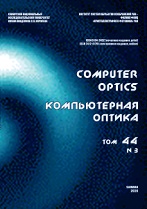|
IMAGE PROCESSING, PATTERN RECOGNITION
Structurally topological algorithm for star recognition and near-Earth space’ object detection
I. G. Zhurkin, L. N. Chaban, P. Yu. Orlov
Moscow State University of Geodesy and Cartography (MIIGAiK),
105064, Moscow, Russia, Gorokhovskii pereulok 4
Abstract:
When solving a variety of celestial navigation tasks there is a problem of determining parameters of spacecraft motion and onboard primary payload orientation based on the coordinates of registered star images. Furthermore, unwanted objects, like active satellites, natural and artificial space debris, that reduce the probability of correct recognition may get into the field of view of a satellite sensor. This prompts the necessity to filter out such interference from the star field images. However, if the objects under recognition are bodies located in near-Earth space, in this case, the star images themselves will act as interferences. In addition, since the detection and cataloging of these objects from the Earth’s surface is complicated by their small size, the atmospheric effects, as well as other technical difficulties, it is worthwhile to use the existing equipment onboard spacecrafts to solve this task. The existing recognition algorithms for star groups, as well as their classification, are presented in this paper. Moreover, a structurally topological approach for identifying groups of stars based on the properties of enveloping polygons used in constructing topological star patterns is proposed. Specific features in the construction of topological configurations on the analyzed set of points, as well as the principles of dynamic space object detection within their limits are described. Results of the numerical experiments performed using the developed algorithm on the star field maps and model scenes are presented.
Keywords:
star recognition, star pattern, digital image processing, autonomous navigation, remote sensing, near-Earth space, space debris, space object.
Received: 12.07.2019
Accepted: 03.04.2020
Citation:
I. G. Zhurkin, L. N. Chaban, P. Yu. Orlov, “Structurally topological algorithm for star recognition and near-Earth space’ object detection”, Computer Optics, 44:3 (2020), 375–384
Linking options:
https://www.mathnet.ru/eng/co799 https://www.mathnet.ru/eng/co/v44/i3/p375
|

| Statistics & downloads: |
| Abstract page: | 110 | | Full-text PDF : | 46 | | References: | 17 |
|




 Contact us:
Contact us: Terms of Use
Terms of Use
 Registration to the website
Registration to the website Logotypes
Logotypes








 Citation in format
Citation in format 